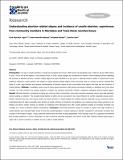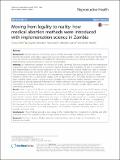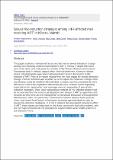| dc.contributor.author | Yegon, Erick Kiprotich | |
| dc.contributor.author | Kabanya, Peter Mwaniki | |
| dc.contributor.author | Echoka, Elizabeth | |
| dc.contributor.author | Osur, Joachim | |
| dc.date.accessioned | 2021-08-12T10:14:20Z | |
| dc.date.available | 2021-08-12T10:14:20Z | |
| dc.date.issued | 9/26/2016 | |
| dc.identifier.citation | Yegon, E. K., Kabanya, P. M., Echoka, E., & Osur, J. (2016). Understanding abortion-related stigma and incidence of unsafe abortion: experiences from community members in Machakos and Trans Nzoia counties Kenya. Pan African Medical Journal, 24(1). | en_US |
| dc.identifier.issn | 1937-8688 | |
| dc.identifier.uri | https://www.ajol.info/index.php/pamj/article/view/144563 | |
| dc.identifier.uri | http://dspace.amref.org/handle/123456789/48 | |
| dc.description | This is an open access journal article published by Pan African Medical Journal in AJOL | en_US |
| dc.description.abstract | Introduction: The rate of unsafe abortions in Kenya has increased from 32 per 1000 women of reproductive age in 2002 to 48 per 1000 women
in 2012. This is one of the highest in Sub-Saharan Africa. In 2010, Kenya changed its Constitution to include a more enabling provision regarding
the provision of abortion services. Abortion-related stigma has been identified as a key driver in silencing women's ability to reproductive choice
leading to seeking to unsafe abortion. We sought to explore abortion-related stigma at the community level as a barrier to women realizing their
rights to a safe, legal abortion and compare manifestations of abortion stigma at two communities from regions with high and low incidence of
unsafe abortion. Methods: A qualitative study using 26 focus group discussions with general community members in Machakos and Trans Nzoia
Counties. We used thematic and content analysis to analyze and compare community member's responses regarding abortion-related stigma.
Results: Although abortion is recognized as being very common within communities, community members expressed various ways that stigmatize
women seeking an abortion. This included being labeled as killers and are perceived to be a bad influence for women especially young women.
Women reported that they were poorly treated by health providers in health facilities for seeking abortion especially young unmarried women.
Institutionalization of stigma especially when Ministry of Health withdrew of standards and guidelines only heightened how stigma presents at the
facilities and drives women seeking an abortion to traditional birth attendants who offer unsafe abortions leading to increased morbidity and
mortality as a result of abortion-related complications. Conclusion: Community members located in counties in regions with high incidence of
unsafe abortion also reported higher levels of how they would stigmatize a woman seeking an abortion compared to community members from
counties in low incidence region. Young unmarried women bore the brunt of being stigmatized. They reported a lack of a supportive environment
that provides guidance on correct information on how to prevent unwanted pregnancy and where to get help. Abortion-related stigma plays a
major role in women's decision on whether to have a safe or unsafe abortion. | en_US |
| dc.language.iso | en | en_US |
| dc.publisher | Pan African Medical Journal | en_US |
| dc.subject | Abortion | en_US |
| dc.subject | Unsafe abortion | en_US |
| dc.subject | Kenya | en_US |
| dc.subject | Reproductive health | en_US |
| dc.subject | Abortion stigma | en_US |
| dc.subject | Legal abortions | en_US |
| dc.subject | Women | en_US |
| dc.title | Understanding Abortion-Related Stigma and Incidence of Unsafe Abortion: Experiences from Community Members in Machakos and Trans Nzoia Counties Kenya | en_US |
| dc.type | Article, Journal | en_US |



